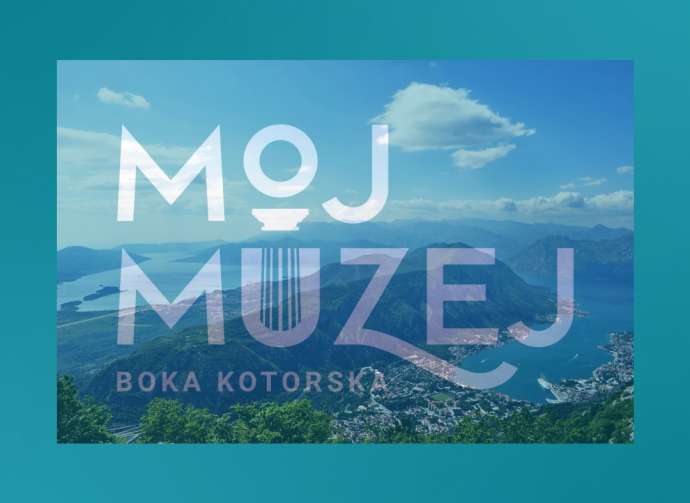August 24, 2020 - What are all the elements that define the cultural heritage of a particular community? What are their values? Who are the bearers of that culture, and how vital is their active participation in its preservation? These are just some of the questions that the project My Museum - Boka Kotorska, which is being realized by art historian Maja Marović, is trying to answer.
As part of the campaign by the Ministry of Culture of Montenegro, "Let's live culture", Maja has launched a research, educational and creative project that offers an interactive online platform for the digital presentation of cultural, historical, and artistic material provided by a broad audience. The public is invited to submit content on people, memories, legends, customs, rituals, practices, skills, crafts, sites, objects, speech, language, useful objects, or objects of artistic value, which are not entirely or professionally valorized. Maja starts from the perspective that if something is of specific value in the context of the family tradition, it has value for the community. After the professional-scientific processing, all material submitted will be available to the broadest audience.
We bring you an interview with the creator and coordinator of My Museum - Boka Kotorska, Maja Marović.
- What motivated you to embark on such a comprehensive and demanding project?
During the lock-down, the Ministry of Culture announced a vacancy to help unemployed cultural workers. They invited artists, art historians, and other cultural workers to get involved and propose projects that would be educational, have an interactive dimension, and possibly rely on research, but with the task of delivering the project's activities online. That I, as a project coordinator, can work online, but also engage the community, to make some cultural content accessible to them and to enable them to be actively involved in the project. After reading the competitions' propositions, I came to this idea, which is quite complex and broad. Still, it comes down to the fact that the project is of a research, educational, and creative character, and that I try to make the most of new media. The project also aims to draw attention to how little digital technology is present in the approach to heritage. In Europe, a lot of money is invested in digital heritage concepts, digital heritage management, ways in which material can be processed, presented on virtual platforms, and accessible to a broad audience.
Projects of this type are not usual; there is no one model I could refer to. I decided on an idea that is quite radical because I have turned the situation around. The museum is the backbone in its traditional meaning - an institution that deals with the collection, processing, research, preservation, and presentation of our cultural heritage. These are the fundamental reasons why we have museums at all. Switching to a virtual platform usually means that there is already a museum as an institution that transfers some of its collections or exhibitions or selections of curators online.
I try to think from the opposite perspective, from the position of the virtual. How it works online, what opportunities new media offer us. The classical museological approach is based on the curator choosing the material to be collected and making his selection. He is the one who contemplates in many different directions. The end-user then comes to the fore, not asked about the content and how it will be presented. I believe that people are the force of culture, the community that is the bearer of cultural heritage, and that it defines what that heritage is. In essence, it all comes down to individuals forming a community that inherits a particular culture.
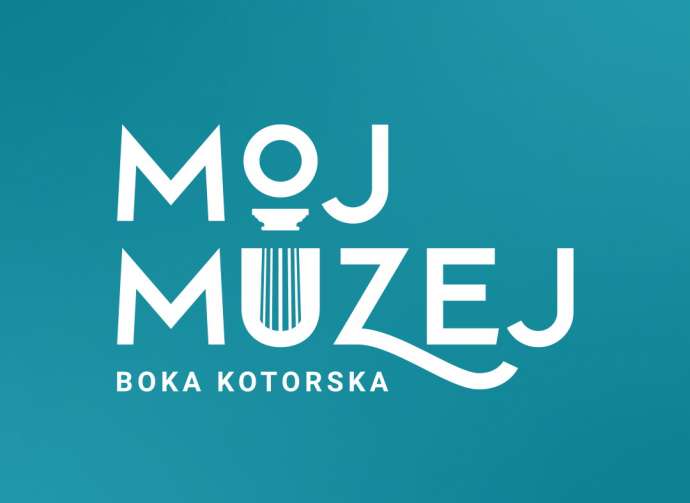
My Museum - Boka Kotorska logo
- The Bay of Kotor is a specific area when it comes to cultural heritage. Of course, we have museums as institutions. Still, the fact is that comprehensive research and analysis of the culture of the Bay of Kotor, especially its intangible cultural heritage, goes beyond the activities of museums in the classical sense of the word. The project My Museum - Boka Kotorska offers for the first time a platform that can capture what seems elusive, which eludes the generations that are leaving, and precisely defines the culture of life in this area.
The project My Museum - Boka Kotorska is of an experimental nature and uses new opportunities provided by new media. It relies primarily on citizenship. I'm sure there are plenty of people who have entire collections at home but don't know who to turn to to make those values available to others. Many people are not even aware of how much wealth they keep in their memories, how many valuable stories they have to tell, and which are essential to all of us. We need to find ways to make them available to us.
The biggest problem was how to design it methodologically, how to enable people to respond to so many topics that go into what is our cultural heritage. How to give them the right guidelines, how to prepare questionnaires and forms to help them go through at least partially the process that an expert is going through in a museum. Therefore, the interested participant is trained on how to approach heritage topics. Then through my processing and presentation- and I hope over time, there will be more colleagues to help me with that- they understand that value and become available to everyone.
This way of involving the community raises the collective awareness of the values and importance of preserving all different cultural heritage segments, allowing each individual to participate directly in the process.
The idea is to empower people, to examine what they perceive as the cultural values of our space. It is quite experimental - I don't know if people will react. So there is one element of risk. I was informed about comparable initiatives being implemented abroad. It is about existing museums that introduce the audience to the presentation of content but on some pre-defined topics. Or they are invited to submit some items or materials on a specific topic. But no project would allow them to determine in which direction it will go. And My Museum - Boka Kotorska leaves this possibility to every participant in the process.
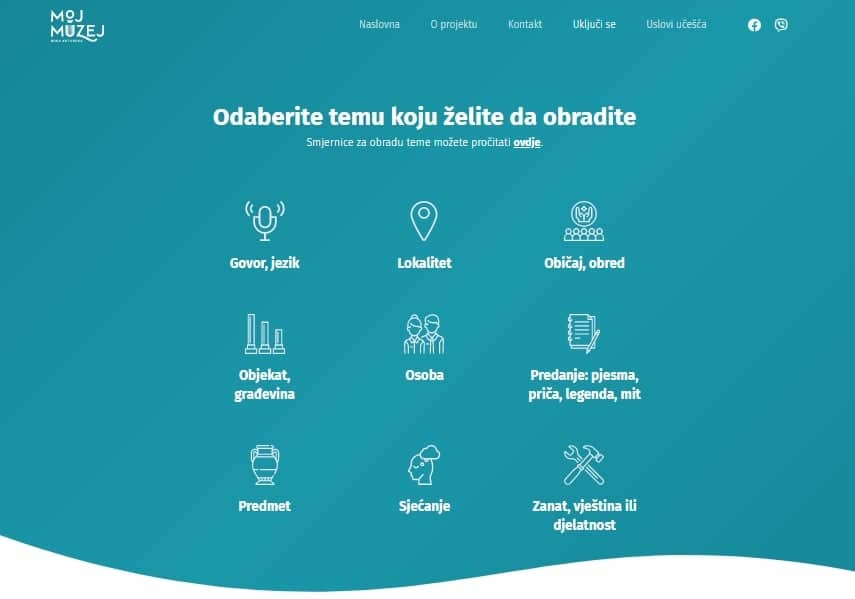
My Museum - Boka Kotorska website, Screenshot
- How will you encourage the public and professionals to join you?
For the past month, I have been conducting a promotional campaign through the Viber community and Facebook. I realized today you have to be transparent and visible; people are on social networks. I learn and examine how they react to what amount of content, how to present information so that it is receptive, that there is a scientific insight behind each topic. To submit some content, I consult several professional and scientific papers to filter out information that is as accurate and relevant as possible and to adapt it to a broad audience to which the profession must open up. Literally - I want to reduce the gap between the professional, i.e., scientific community, and the broad public. It seems that the professional and scientific community are primarily focused on writing scientific papers, often being separated from content of interest to them.
I am mapping tangible and intangible cultural heritage through this project. Through this process, I will see how much the community is interested in and what they are particularly sensitive to. Based on the experience in the last few years since I returned to Boka, I can say that people are really interested in culture in general and even cultural heritage. The prevailing climate makes the situation seem desperate; we get the impression that people are not interested in anything and don't care about anything. But that is not the case. Channels need to be opened to establish communication. There is interest. If I hadn't recognized it, I would never have entered the project My Museum - Boka Kotorska.
Through communication with the public and through the invitation I sent to institutions and experts, I will see how interested they are in getting involved in this project.
- The eternal problem in Montenegro is the lack of funds for cultural projects that are not primarily commercial.
Indeed, not everything depends on the responsibilities of individuals in cultural institutions. It also depends a lot on the available funds. If someone is going to deal with big projects within an institution, he needs additional funds. And serious projects, especially of a scientific nature, require teams of people and require significant investments.
Competitions like the one announced by the Ministry of Culture instill hope. I had no particular expectations, I submitted the project, and it turned out that I received all the funds I asked for. I tried to plan the budget to get the maximum effect through the project. All of us took on work for more people, all in the desire for the project to succeed. To set up a sufficiently broad and comprehensive platform that can be further developed.
The project is short-term, lasting three months. But my idea is not for it to be completed in three months, but to use that time to set up a platform that we can all develop together afterwards. I hope that a team of people will come together, and it is essential to emphasize that the platform we are developing later can be used for many other projects.
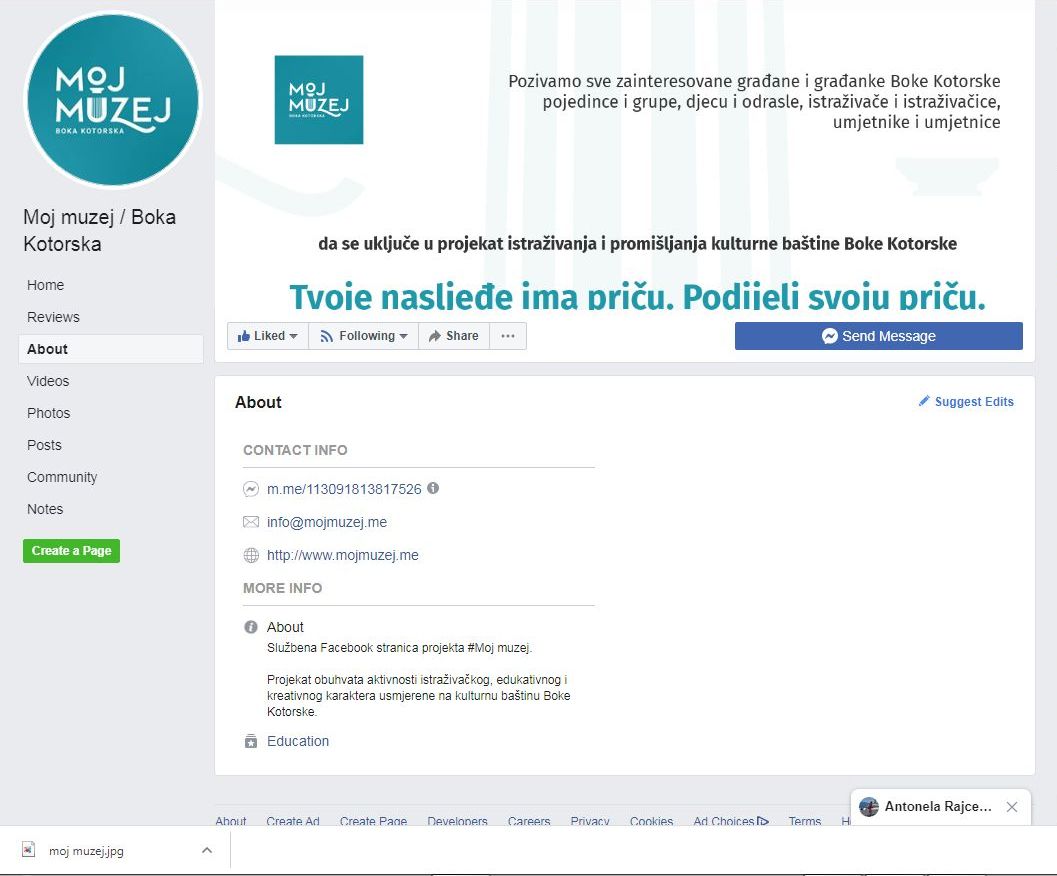
My museum - Boka Kotorska Facebook page, Screenshot
- After the Viber community and social media pages, you launched a technically very high-quality website that defines frameworks and guidelines and offers tools to experts and laypeople interested in getting involved.
The website is set up as a platform for collecting, processing, and presenting material provided by a broad audience and divided into three segments concerning the public, researchers, and artists. The website is very complex; I needed the support of IT experts. I have to thank Igor and Darko Marić, who are our technical and creative support. Igor is a designer and is responsible for the logo of My Museum - Boka Kotorska, for all innovative solutions, and the Guide for Children's design. At the same time, Darko is an IT engineer who signs software solutions. Out of his enthusiasm, he invested a lot of knowledge and time to enable people to submit their material to the simplest. They can download a form that I have prepared, and Igor has designed in PDF, which they can fill out in their spare time and send via email or other means.
- When it comes to awareness of the importance of our cultural heritage, you have set yourself another very demanding goal: communication with the youngest. In this sense, the most important target groups of your project are parents and teachers.
Precisely because of the situation with the coronavirus epidemic and the restriction of movement, people are more at home, so I started from the fact that it is an ideal opportunity for the family to talk about some things that they may not have time for before and after. Sometimes I ask the kids if they talked to their grandparents or some older ones once about what space looked like when they grew up, how they played. No, they never did. Did they show you old albums? They never did. I thought it would be interesting to stimulate children who are already fully interactive through mobile phones, laptops, computers. They are our hope for the future, in which we should invest the most, to talk to the elderly, who may not be so comfortable with these technologies, so that they can work together.
It can be educational for children in many ways. They will talk to their elders, learn something from talking to people who are living bearers of our cultural heritage, and take on the tasks themselves. We have developed a Heritage Research Guide, believing that this is the best way to introduce them to the story. I didn't just want to give them dry guidelines, but to gain knowledge and experience useful for other projects. Igor tried to design it all with likable illustrations to get as close to them as possible. I hope that the children will react well, that teachers and parents will invite them to get involved. They will need help and support. I will repeat what I told them in the guide - they can feel like detectives. It's a kind of detective job. I often feel that way when I research something, there is also a fun aspect, which is promising when you approach children.
- You are the author of the complete concept and all content on the networks and the website. You mentioned the technical support and enthusiasm of Igor and Darko, thanks to which My Museum - Boka Kotorska was put on its feet in an incredibly short time. But, you will also need the support of colleagues for the Museum to come to life in the way you imagined.
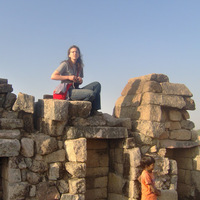 I must already thank the expert consultant Igor Lazarević, ethnologist and anthropologist, whose assistance will prove invaluable going forward. I spent hours and hours with Igor talking about history, the history of art, ethnology related to the area of the Bay of Kotor. Igor's help is crucial because I needed someone who is in a complementary profession. I don't want to pretend to be an expert in all segments of heritage. I can research the curatorial role; in museology, I can process a lot of things. But I think another, expert opinion is always needed. I expect that there will be a lot of material, so I hope for a response from colleagues. It will depend on the reaction of people whether this project will come to life or not.
I must already thank the expert consultant Igor Lazarević, ethnologist and anthropologist, whose assistance will prove invaluable going forward. I spent hours and hours with Igor talking about history, the history of art, ethnology related to the area of the Bay of Kotor. Igor's help is crucial because I needed someone who is in a complementary profession. I don't want to pretend to be an expert in all segments of heritage. I can research the curatorial role; in museology, I can process a lot of things. But I think another, expert opinion is always needed. I expect that there will be a lot of material, so I hope for a response from colleagues. It will depend on the reaction of people whether this project will come to life or not.
I am currently working very hard to complete everything on time, intending to show what we can do within this story. The life of the My Museum - Boka Kotorska project depends on the community, experts, colleagues, the support of institutions, and the funds. I hope there will be support. There is no lack of enthusiasm. We have quality experts both in institutions and those we don't know about, who can contact us, get a space that they felt they didn't have or don't have, and try to create lasting value together.

